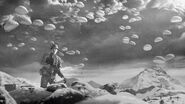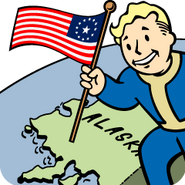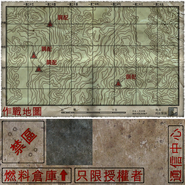Cleanup (Issue: just needs additional references in background section to make it a bit more solid)
To meet Nukapedia's quality standards, this article or section may require cleanup. Please help by improving the article.
|
| For the simulation in Fallout 3's Operation: Anchorage add-on, see Anchorage Reclamation simulation. |
The Battle of Anchorage, also known as the Liberation of Anchorage, Anchorage Campaign and the Anchorage Reclamation, was fought between the United States of America and the People's Republic of China, sparked by the Chinese invasion of Alaska in the winter of 2066.[1][Non-game 1]
Background[]
With conditions deteriorating between the U.S. and China, a strengthened military presence in Alaska was established to prevent a possible invasion across the Bering Strait. Increasingly scarce fossil fuel reserves across the entire world saw many larger nations struggle and attempt to locate and claim what few reserves remained. A large deep-sea oil deposit in the Pacific Ocean was located and claimed by China before, allegedly, being sabotaged by American special operatives. Following this, the already strained relationship between the two countries spiraled into full-blown conflict. As was expected, but underestimated, the Chinese mobilized a massive task force, invading northern Alaska and attempting to assault as far south into United States territory as possible, with a specific focus on taking the capital and removing the political and military high command structure. This officially began the Sino-American War. Under the command of General Jingwei, the People's Liberation Army took control of Alaska's oil pipelines and reserves while deploying scores of sleeper agents and stealth-armored soldiers around the country (including the Washington, D.C. region) to cripple defenses and sow discord.[Non-game 2]
Under the leadership of General Constantine Chase, the U.S. Army fiercely defended the front lines of the conflict before Chase began to deploy specialized power armor units, such as the first introduction of the T-45 series. While the T-45 acted as an effective buffer to the Chinese forces in the region for a time, it was ultimately a stopgap measure, as Chinese marksmen and the Crimson Dragoons, with state-of-the-art Hei Gui stealth armor, would pick apart flaws in the armor's design. This, combined with the rapid consumption of energy cells, made the T-45 ineffectual. It would not be until the introduction of the T-51 series power armor,[2] that US forces would begin pushing the Chinese back. Future power armor suits were further refined as the conflict dragged on, and the Trans-Alaska Pipeline was reclaimed. With American resources flowing through Canada, strained diplomatic relations between the two countries became problematic for the United States. Canada was then militarily annexed following the near sabotage of the Alaskan pipeline by Canadian freedom fighters.[Non-game 2]
With a combination of inclement weather, constant American bombardment, trench warfare and U.S. power armor units attacking mainland China impeding logistics, the Chinese supply lines were severely weakened. By January 2077, the city of Anchorage was finally liberated and the Chinese presence was removed.[Non-game 2] A commemorative memorial was erected in Washington, D.C., in honor of the soldiers who fought and perished for the United States. Violence between American forces and pockets of Canadian freedom fighters continued throughout 2077, up until the Great War. This led to resistance within the United States by citizens concerned with the state of society, with the government and media labeling them as "pinkos," "communists" or "agitators," much akin to the Red Scare of the mid-20th century. According to the Defense Intelligence Agency, the full clean up of the remnant Chinese force was achieved on January 28 at 16:32 and the U.S. lowered their DEFCON status to DEFCON 3.[3]
The occupation lasted over a decade, with the United States unable to rout Chinese entrenchments until the deployment of second-generation power armor units. Despite finally defeating the Chinese invasion force, this did little to assuage the American populace, with many believing this had backed China into a desperate corner. Following the Battle of Anchorage, more advanced power armor units such as the T-60 series power armor began to see use.[4]
Appearances[]
The Battle of Anchorage appears as a simulation in the Fallout 3 add-on Operation Anchorage and in the intro of Fallout 4. The location is also mentioned in Fallout, Fallout 2, Fallout 3 and Fallout 76.
Behind the scenes[]
Armstrong, a character from the canceled Van Buren project, fought during the battle.[Non-canon 1]
Gallery[]
References[]
- ↑ 1.0 1.1 Capitol Post terminal entries; Capital Post Top Stories --January 11, 2077, Commies Crushed - Alaska Liberated!
- ↑ Fallout 4 loading screens: "The T-51 series of Power Armor was the pinnacle of mechanized protection before the Great War. First introduced in the Battle of Anchorage, it is highly valued today for its increased protective capabilities."
- ↑ Switchboard terminal entries; central terminal, DEFCON Status - 2077
- ↑ Fallout 4 loading screens: "The T-60 series of Power Armor saw extensive use by the United States Army after the Battle of Anchorage. In fact, soldiers in T-60 Power Armor were among those trying to retain order on October 23, 2077 - the day America fell to atomic war..."
Non-game
- ↑ Fallout history marketing picture
- ↑ 2.0 2.1 2.2 Fallout 3 Official Game Guide Game of the Year Edition p.43:
"Operation: Anchorage Factions, Chinese Army Simulated U.S. Army Simulated"
"With conditions deteriorating between the United States and China, a military presence in Alaska was established to prevent a possible invasion across the Bering Strait. With increasingly scarce oil reserves, a last deep-sea deposit below the Pacific Ocean was claimed by China before allegedly being sabotaged by American special operatives. Strained relationships spiraled downward into conflict as China marched on Alaska, and the Sino-American War of 2066—2077 erupted. Under the command of General Jingwei, the Chinese Army usurped control of Alaska's oil pipeline and reserves. In response, the Americans began what came to be called 'The Alaskan Reclamation Operation' (2067—2077).
Under the leadership of General Constantine Chase, the U.S. Army battled fiercely to the front lines of the conflict before Chase began deploying specialized Power Armor units that began pushing the Chinese back. Future Power Armor suits were further refined as the conflict dragged on, and the Trans-Alaska Pipeline was reclaimed. With resources flowing through Canada, strained diplomatic tensions between Canada and the United States becoming problematic, and Canadian forces attacking the pipeline, the country was annexed.
A combination of inclement weather, constant American bombardment and trench warfare, and U.S. Powered Armor unit attacks sweeping through mainline China, the Chinese supply lines weakened and finally broke down completely. By the beginning of 2077, the city of Anchorage was finally liberated, the Chinese eradicated, and the operation deemed a success. A commemorative memorial was erected in Washington, D.C., in honor of the soldiers who fought and perished for the greater American good. Violence between America and pockets of Canadian freedom fighters continued throughout 2077, until the Great War obliterated almost all infrastructure, commerce, and human life."
(Fallout 3 Official Game Guide faction profiles)
Non-canon
- ↑ Armstrong: "I am trained in the use of light and heavy assault weapons and have fifty three hours of field experience in the T-45d power armor, citizen. Most of those were during the Anchorage Reclamation."
(Armstrong dialogue file)







